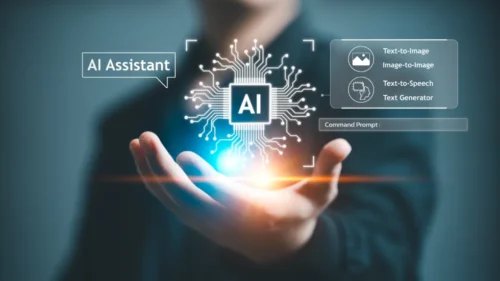In 2007, Steve Jobs audaciously said, “iPhone is a revolutionary and magical product that is five years ahead of any other mobile phone.” The response was a chorus of pessimism from competitors and mainstream media that Apple would never come close to its goal of selling 10 million phones in 2008.
Early on, most enterprise leaders failed to grasp the magnitude of the Mobile Wave on their customers and employees. They focused only on “building an app” rather than transforming their operating and business models to fully unlock the mobile opportunity. Despite their massive investment, users abandoned two-thirds of mobile apps after the first 30 days. Companies that were slow to see mobile as an innovation opportunity versus simply as another communication channel became laggards or roadkill in their respective industries.
Fast forward to 2021, when OpenAI CEO Sam Altman made a similarly audacious statement about AI: “This technological revolution is unstoppable. This revolution will create phenomenal wealth. The price of many kinds of labor (which drives the costs of goods and services) will fall toward zero once sufficiently powerful AI joins the workforce.”
The AI Wave is growing fast. Billions of people globally are using foundation models like ChatGPT, Claude, Gemini and Llama, along with a sprawling number of vertical generative AI (GenAI) applications. Many enterprises have leaned into this new wave, with over 70% using GenAI in their enterprises; however, just 15% are achieving real business impact at scale. Sound familiar?
What can enterprises learn from the Mobile Wave that might help them avoid the same challenges in achieving real transformation in the AI Wave? Let’s start by looking at the similarities and differences between the two waves.
What do the AI and Mobile waves have in common?
Apple blew away its goal by selling 13 million phones in 2008. It has since sold 2.3 billion iPhones, created the app store model to democratize app innovation and completely transformed how we communicate, interact and consume content. Its intuitive interface, coupled with a powerful computing platform, captivated users across the globe.
Likewise, GenAI, the latest AI technology, offers unprecedented new capabilities that can create content, conduct analyses and allow humans to interact with machines in more natural ways. Ultimately, the technology could make machines as intelligent, or even more so, than humans. Similar to mobile, GenAI will:
Change what is possible. Mobile technology initially changed how consumers and employees did everyday tasks. Eventually, entrepreneurs tapped into the “always on” connectivity to deliver new services (e.g., real-time fitness feedback) and change business models. AI companies like Humane and Rabbit are creating personal AI devices (PADs) that are helping us envision a future of virtual assistants and agents accessed via natural language. Just like with mobile, innovative products and business models will follow.
Challenge the status quo. Smartphones displaced many consumer devices, including home phones and cameras, undermining seemingly strong competitive advantages in other industries. GenAI could be even more disruptive as it takes on advice- or language-based services, content creation and analysis. Google is already disrupting its own business model as it replaces search results with AI-generated answers. A single virtual assistant (e.g., Apple Intelligence) may replace many apps.
Devour data to create relevant and extraordinary experiences. With user permission, smartphones gave brands (or apps) users’ location, elevation, movement and more. Smart algorithms enabled them to teach people to dance or detect the early onset of Alzheimer’s. GenAI’s massive computing power will make these examples seem rudimentary. GenAI can already understand users’ digital behaviors. Ultimately, the models will build a more holistic understanding of users by observing them in the physical world (speech, movement, consumption, etc.). GenAI-fueled services will use these learnings to mimic us, assist us and offer insights that both reduce costs and create new sources of revenue for businesses.
Depend on and exploit infrastructure owned and operated by third parties. The evolution of mobile services depended on massive and ongoing investments in advanced device technology, cloud computing, developer platforms, data centers and cellular networks. Since the iPhone launched, AT&T’s market cap has declined nearly $100 billion to $139 billion while Alphabet’s, Apple’s and Meta’s have grown by hundreds of millions to $2 trillion, $3 trillion and $1 trillion, respectively. So, too, will GenAI. With $200 billion expected to be invested in GenAI by 2025, the major infrastructure and platform players will be under pressure to recover their investment under similar pricing pressure that comes with assets perceived as commodities.
Create new business opportunities and revenue for third parties. Apple has paid out more than $320 billion to third-party developers since the launch of its app store. In 2023, Uber generated more than $38 billion in annual revenue. IDC forecasts that enterprises invested more than $19.4 billion in GenAI solutions in 2023 and expect it to double in 2024, focused on both efficiency gains and new revenue streams. Questions still remain about the uptake speed of GenAI solutions and what existing services they will ultimately displace.
How do the AI and Mobile waves differ?
AI’s innate ability to improve itself, along with growing regulatory scrutiny, will create a non-linear, unpredictable trajectory unlike mobile’s steady rise. GenAI’s impact will be different because:
AI consumer adoption will be faster as consumers don’t need to buy new devices. Mobile’s growth initially depended on consumers upgrading their smartphones every 18 to 24 months as well as the build-out of progressively more capable networks or infrastructure. No one was ready for the Internet to be everywhere. Today, they are. Most services are fundamentally digital — if they weren’t pre-2020, they are now. While hardware manufacturers are building their next generation of devices with local large language models (LLMs), most of the massive computing will be done in the cloud, which means consumers can start with the devices they already own.
Data is essential, but users have more privacy concerns, as do regulators. Crafting relevant, convenient and personalized experiences depends heavily on user data. Tech giants burned proverbial bridges with consumers and regulators while failing to respect consumer privacy. While Europe’s General Data Protection Regulation (GDPR) did not come into effect until 2018 (Google was founded in 1998 and Facebook in 2004), Europe’s AI Act went into effect on August 1 of this year, setting a high bar for new and existing models. Meanwhile, large media companies such as The New York Times are suing the LLM creators (e.g., OpenAI) for training their models on their content without permission. Enterprises are also beginning to protect their own data and content by opting out of sharing it for training or quality purposes with those AI model owners.
The pace of change will be even faster as AI will operate autonomously. Humans have built mobile and digital experiences to date. As AI capabilities evolve towards general artificial intelligence or AGI (matches human intelligence) and Super AI (exceeds human intelligence), these “tools” will start to generate their own experiences and no longer depend on human labor. Agents are beginning to self-correct and work together. Capabilities are progressing quickly despite the need for resources like GPUs, power, data and human training, as well as ethical, safety and regulatory concerns.
Customer and enterprise acquisition costs will be higher for new app entrants. Customer acquisition is difficult. An existing installed base or billing relationship gives companies a head start for at least two reasons. First, GenAI will initially augment existing services. Think of Siri (i.e., Apple Intelligence) or Microsoft Copilot for employees. Second, applications will need history and data (i.e., long-term relationships) about individuals to evolve into true virtual assistants. The more an entity or AI-based service knows about a human, the more it can anticipate needs and deliver contextual or personalized experiences. Doing so ultimately increases switching costs.
Factors outside of the control of LLM makers will constrain growth. Brands building mobile experiences have always faced business model or capability constraints of the mobile ecosystem. LLMs face even more hurdles. First, advancing models requires more training data or content. While LLMs can generate synthetic data, the next leaps forward depend on content (e.g., video) and physical world data (e.g., chemistry or nature) that isn’t available. Next, there are physical limitations, including access to GPUs for training or the electricity, water and human talent required to train the models. Finally, government regulators are already nervous about not only the use of consumer data but also the ethical, controllable or known outcomes of these models.
Five steps for leaders to navigate the AI wave
Reflecting on the lessons of the past from the Mobile Wave, what can enterprises do differently to avoid the pitfalls of the AI Wave? Here are five key steps leaders can act on today.
- Don’t underestimate the amount of change required in your organization, business and operating model. Just as winners in the Mobile Wave were those that innovated well beyond “building an app,” winners in the AI Wave will be those that focus on transforming products, services, experiences and ways of working. Don’t bring yesterday’s thinking into your future AI-first business.
- Empower your employees, or they will innovate around you. Chief information officers battled to keep iPhones from popping up in their businesses until they realized they could no longer fend off a better experience. “Bring your own device” (BYOD) became the new enterprise model as BlackBerrys waned and security and controls improved for managing employees’ personal devices. Companies must now embrace “Bring your own AI” (BYOAI) with the appropriate controls to allow employees to use the latest GenAI tools for productivity and innovation while protecting enterprise data.
- Get your data strategy and infrastructure ready to move at the same speed as AI. Data will be the oxygen that powers new AI-driven experiences and operations. This will include both structured and unstructured data or content to train and optimize new GenAI-based solutions. The ability to collect, clean, transform and expose data to innovators across your business with the right security, privacy and controls will be fundamental to staying ahead of this next wave. This includes setting clear data-sharing policies for employees and third parties vital for improving GenAI models; for example, Figma gives users the option to share or not share their data when using its new GenAI features.
- Build a culture of accountability around AI solutions to innovate responsibly. Your customers and employees will depend upon accurate and ethical outputs of GenAI applications. Creating and communicating a responsible AI policy that fits your company’s strategy and values is an essential first step. Building a sense of co-creation and ownership for employees involved in AI innovation will also be critical. Everyone working with AI needs to understand the immense benefits along with the real risks (hallucinations, data security, copyright infringement, etc.) in creating new AI solutions for internal and external users. If you create it using AI, you are accountable for the results.
- Define your own metrics for “ROAI” and use them early. Too many companies are plunging into GenAI experimentation with little to no sense of how they expect to measure real business impact. While it’s important to do pilots to learn, you should invest with an eye toward real business impact. Having your own definition of “Return on AI” (ROAI) will help you better direct your investments across the vast number of AI opportunities.
Like mobile, GenAI brings new superpowers to the end-user and has the potential to drastically transform how companies operate and deliver value to customers. Capitalizing on lessons from the Mobile Wave can only make us more prepared for what’s to come.
[Knowledge at Wharton first published this piece.]
The views expressed in this article are the author’s own and do not necessarily reflect Fair Observer’s editorial policy.
Support Fair Observer
We rely on your support for our independence, diversity and quality.
For more than 10 years, Fair Observer has been free, fair and independent. No billionaire owns us, no advertisers control us. We are a reader-supported nonprofit. Unlike many other publications, we keep our content free for readers regardless of where they live or whether they can afford to pay. We have no paywalls and no ads.
In the post-truth era of fake news, echo chambers and filter bubbles, we publish a plurality of perspectives from around the world. Anyone can publish with us, but everyone goes through a rigorous editorial process. So, you get fact-checked, well-reasoned content instead of noise.
We publish 3,000+ voices from 90+ countries. We also conduct education and training programs
on subjects ranging from digital media and journalism to writing and critical thinking. This
doesn’t come cheap. Servers, editors, trainers and web developers cost
money.
Please consider supporting us on a regular basis as a recurring donor or a
sustaining member.
Will you support FO’s journalism?
We rely on your support for our independence, diversity and quality.











Comment